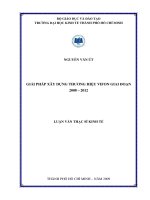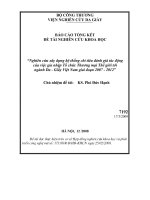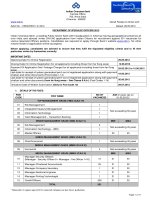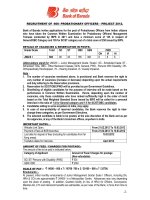50 ThongTinTiengAnh NguyenVanTuyen 2012.pdf
Bạn đang xem bản rút gọn của tài liệu. Xem và tải ngay bản đầy đủ của tài liệu tại đây (684.55 KB, 5 trang )
INFORMATION ON MASTER’S THESIS
1. Full name: NGUYEN VAN TUYEN
2. Sex: male
3. Date of birth:
4. Place of birth: HAI DUONG
03/13/1979
5. Admission decision number: 3568/QĐ-CTSV
Dated: 12/31/2009
6. Changes in academic process:
7. Official thesis title:
Study synthesis ZnO, TiO2 nanomaterials for dye sensitized solar cells
8. Major: Solid state physic s
9. Code: 60 44 07
10. Supervisors: AProf. Dr Nguyen Thi Thuc Hien - Faculty of Physics - University
of Natural Sciences - National University Hanoi.
11. Summary of the finding of the thesis:
Thesis: “Study synthesis TiO2 nanomaterials for dye sensitized solar cells”.
This thesis has achieved the following results:
1. Properties of TiO2 buffer layer
1.1. SEM image
TiO2 buffer layer fabricated by the sol-gel method with spinning covered
technical, which adhere to the substrate ITO and high fineness (figure 1).
Figure 1 . SEM image of the TiO2 buffer layer (sample SG04).
1.2. X-ray diffraction (XRD)
Buffer layer structured TiO2 anatase phase (figure 2).
1
intensity (cps)
Figure 2. XRD of TiO2 buffer layer is annealed at a temperature of 500oC, the
sample SG05.
1.3. Transmission spectrum of the buffer layer
Transmittance(%)
Buffer layer with high transmittance, over 85% in the visible light region,
and less dependent on the annealing temperature (figure 3).
Wave length (nm)
Figure 3. Transmission spectrum of the TiO2 buffer layer was annealed at different
temperatures, samples SG02, SG04, SG05.
2. TiO2 nanorod films fabricated by hydrothermal method
2.1. SEM image
In the process of the experiment we found that the formation of TiO2
nanorod films heavily dependent on the concentration of TBX and pH. TBX
optimal concentration for the formation of TiO2 nanorod films is 0.048 M. At lower
2
concentrations, we found, without the formation nanorod TiO2 films on a base.
When TBX concentration increased, the size of TiO2 nanorod increases (figure 4).
a-sample TN12
(a)
ratio of TBX:HCl:H2O is 1:30:30
Hydrothermal annealing time of 20
hours.
b-sample TN17
(b)
ratio of TBX:HCl:H2O is 1.5:30:30
Hydrothermal annealing time of 20
hours.
Figure 4. SEM image of TiO2 nanorod films with different TBX precursor
concentration.
The best hydrothermal annealing temperature for the formation of TiO2
nanorod thin films is 150 oC. At temperatures lower than 120 ° C, did not see the
formation of TiO2 nanorod thin films on substrate. At a temperature of 180 °C or
more non-film forming that substrate is corroded.
TiO2 buffer layer plays an important role in the formation TiO2 nanorod
films (figure 5).
a-sample TN12
(a)
ratio of TBX:HCl:H2O is 1:30:30
Using the ITO substrate with buffer
layer TiO2
hydrothermal time 20 hours.
3
b-sample TN17
(b)
ratio TBX:HCl:H2O is 1,5:30:30
Use glass substrate without buffer
layer TiO2
hydrothermal time 20 hours.
Figure 5. SEM image of nanorod TiO2 films with (a) and without (b) TiO2 buffer
layer.
Size of TiO2 nanorods depends greatly on hydrothermal annealing time
(figure 6)
a-sample TN10
(a)
ratio TBX:HCl:H2O is 1:30:30
hydrothermal time 4 hours.
b-sample TN12
(b)
ratio TBX:HCl:H2O is 1:30:30
hydrothermal time 20 hours.
Figure 6. SEM image of TiO2 nanorod thin films fabricated by hydrothermal
method with different hydrothermal annealing time.
2.2. XRD
TiO2 nanorod films structured rutile single phase, high crystalline (figure 7)
4
190
d=3.248
180
170
160
150
140
130
120
110
d=1.6863
100
d=2.4874
Lin (Cps)
intensity (cps)
VNU-HN-SIEMENS D5005 - Mau T iO2 - H1
200
90
80
d=2.2951
d=2.0541
40
30
20
d=1.4787
50
d=1.6235
d=2.1879
60
d=1.4520
70
10
0
10
20
30
40
50
60
70
2-T heta - Sc ale
File: ThucHien-Tuyen-TiO2-H1.raw - Type: 2Th alone - Start: 10.000 ° - End: 70.000 ° - S tep: 0.030 ° - Step time: 1.0 s - Temp.: 25.0 ° C (Room) - Anode: Cu - Creation: 11/24/11 11:00:28
21-1276 (* ) - Rutile, syn - TiO2 - Y : 27.27 % - d x by: 1.000 - WL: 1.54056
Figure 7. XRD of TiO2 nanorod thin films, sample TN10.
12. Practical applicability:
The content of the thesis research has high-value applications, it is:
fabrication of electrodes for DSSCs. DSSC is the solution to energy production cost
cheaper than traditional solar cell Si and world interest.
13. Further research directions:
Should be studied performance of TiO2 nanorod film in DSSC in the actual
conditions.
Compare the performance of the DSSC using nanorod TiO2 with film
morphology different columns, different TiO2 buffer layer.
14. Thesis-related publications: None
Date: 12/12/2012
Signature:
Full name: Nguyen Van Tuyen.
5









